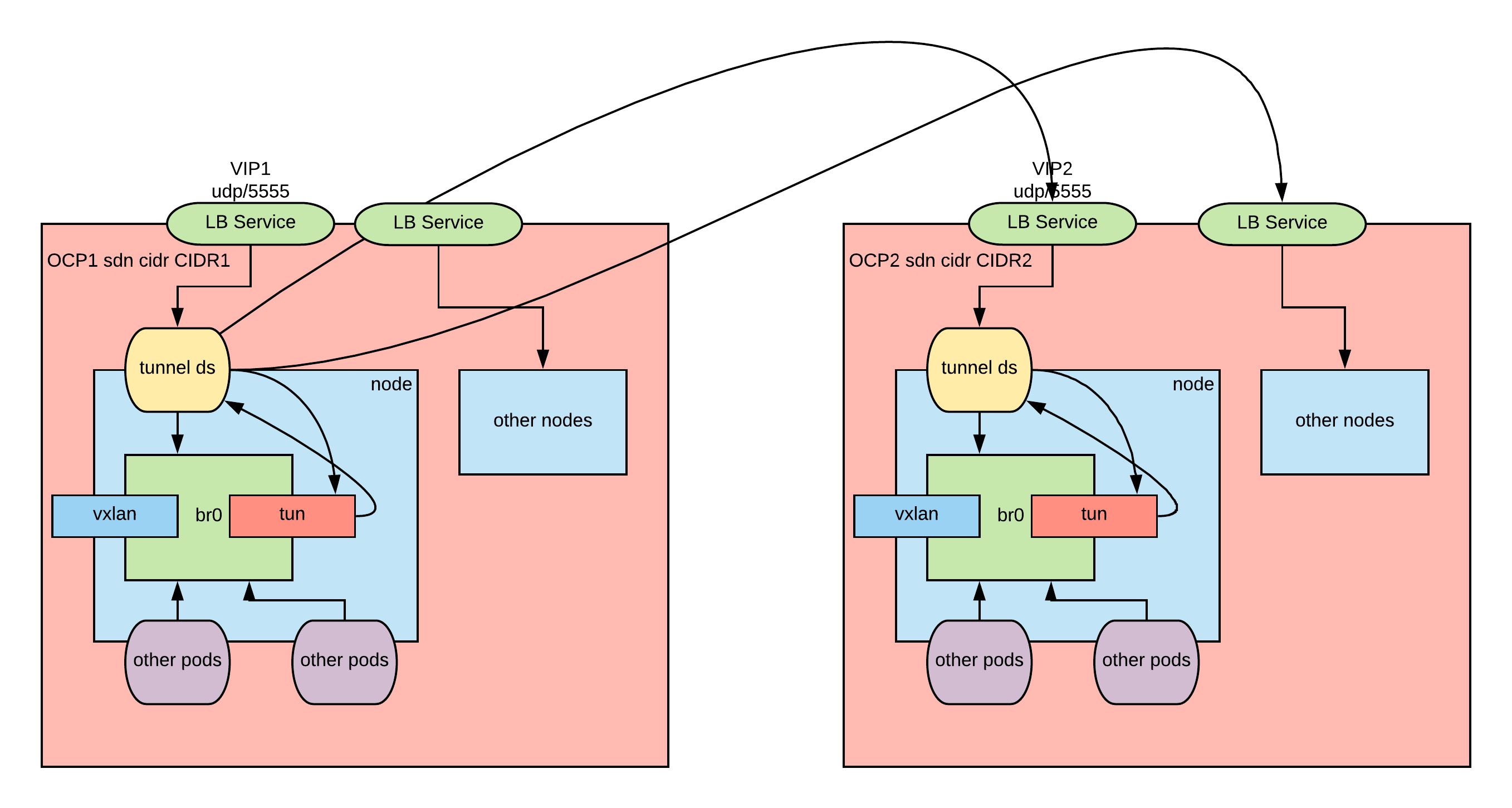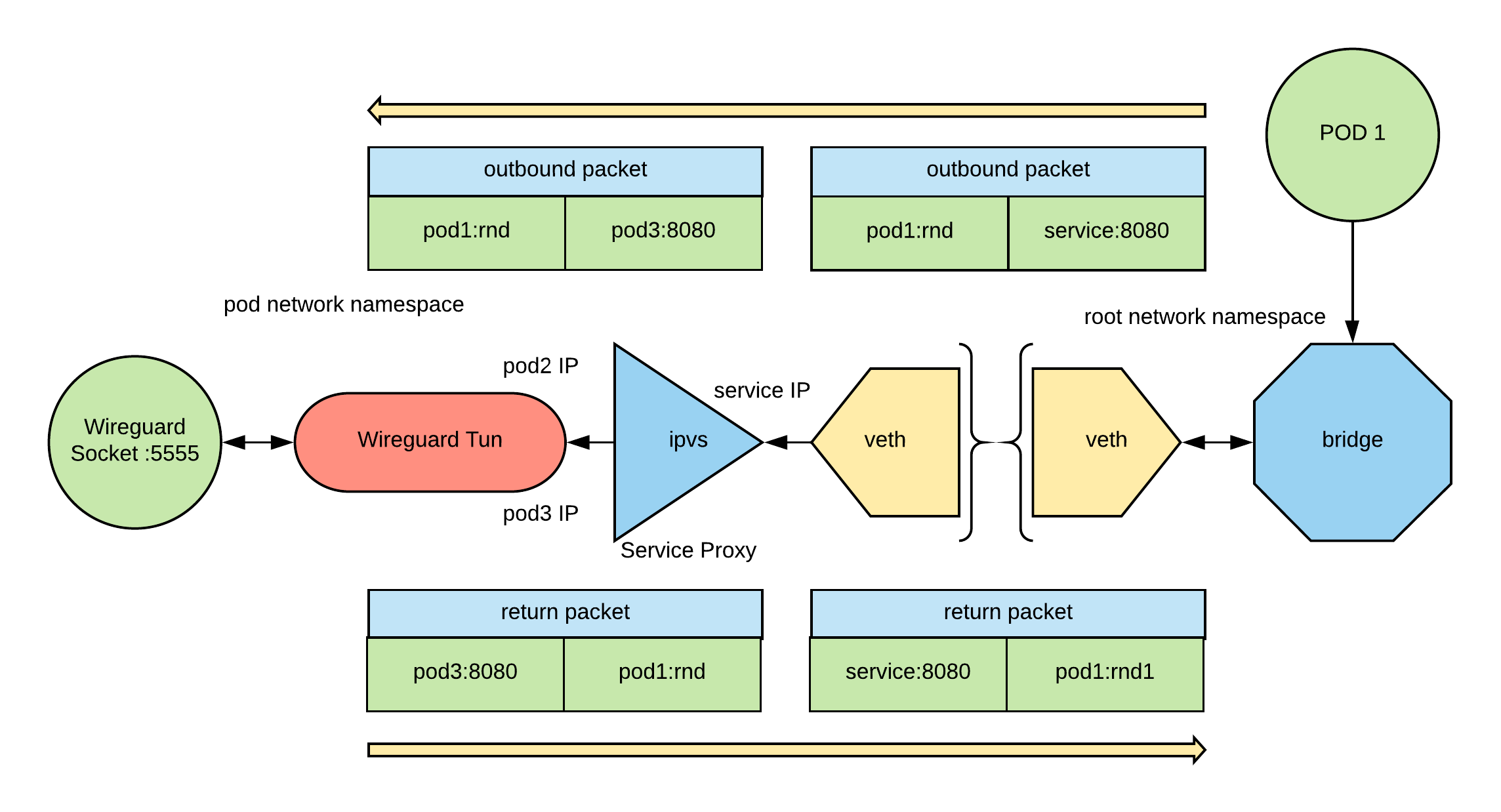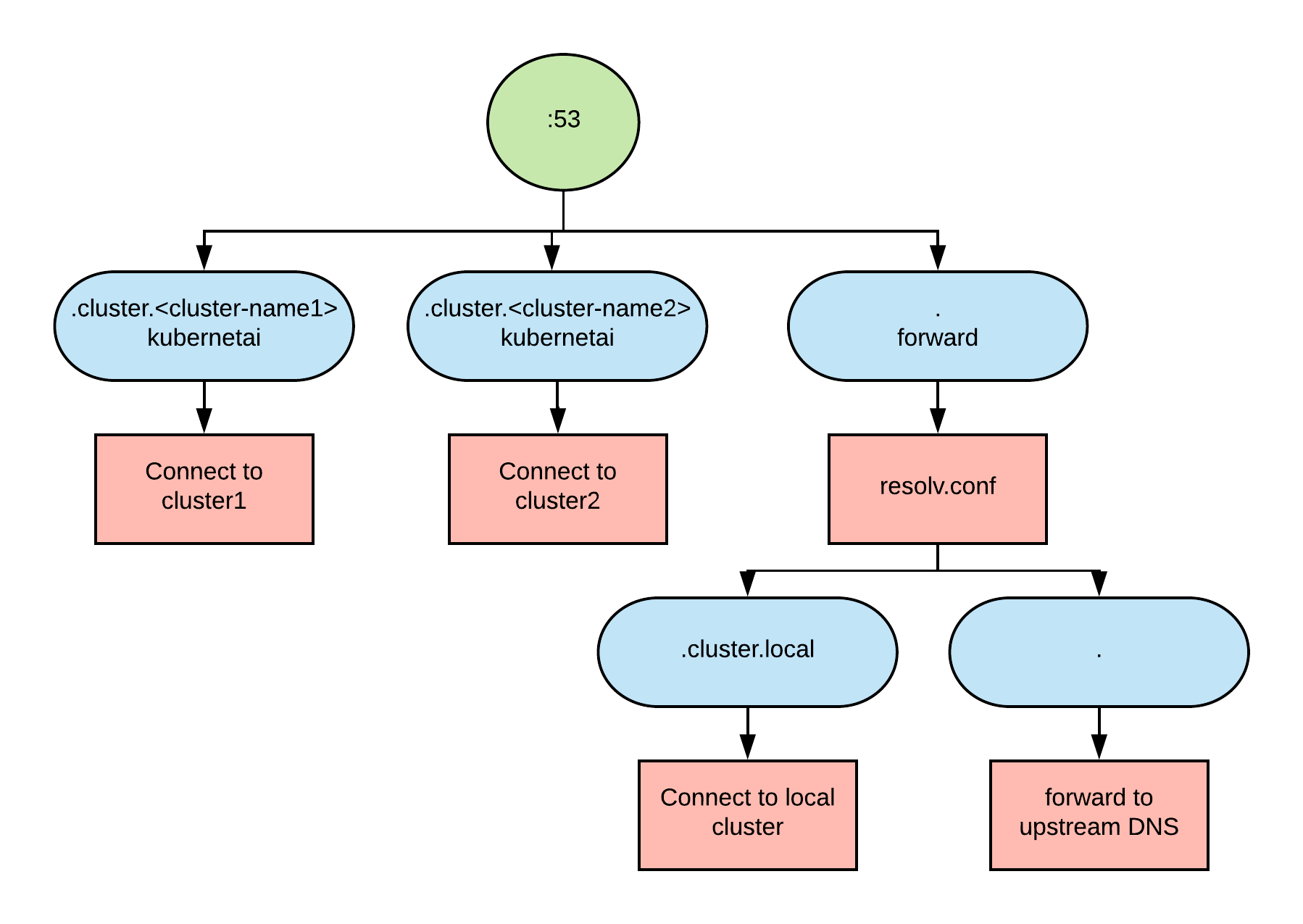OpenShift SDN Ecnrypted tunnel will create a VPN mesh between OpenShift clyster SDNs in such a way that IP packets become routable between pods across SDNs.
The archietcture of the tunnel is depicted in this diagram:
The process works as follows
SETUP PHASE:
- a tun device is created by the tunnel daemon set
- the tun is wired to the bridge so that ip packets destined to the CIDR of the other cluster are routed to the tunnel.
TRANSMIT PHASE:
- a packet is put in the bridge with destination to the CIDR of one of the nodes of the other cluster
- the flow rules send the packet to the tunnel
- the tunnel daemonset process manages the wired side of the tunnel and sends the UDP-encapsulated and encrypted packet to the correct VIP of the other cluster
RECEIVE PHASE:
- A UDP encapsulated and encrypted packet is received by the VIP and sent to the corresponding tunnel ds process
- the tunnel daemonset process extracts and decrypts the packet from the UDP envelope and puts it in the tun device.
- the packet ends up in the bridge.
- the bridge examines the destination, which will be local to the node, and delivers the packet immediately.
The routing of the packets works as described in this diagram:
Service Proxying is the ability to load balance connection to Kubernetes services to pods. In this case we want to be able to load abalnce conenction to a service of a connected Kubernetes cluster to the pods of this cluster. To do so we use IPVS managed by kube-router, the architecture is the following:
Discovery is the ability to discover Kuberneets service IPs by quering a DNS.
We define the convention that each cluster has a domain of this pattern .cluster.<cluster-name>, besides the usual .cluster.local.
We use coredns to setup a DNS server with the followign architecture:
Pods that need to use that DNS need the following in their template:
dnsConfig:
nameservers:
- <coredns service IP>
searches:
- svc.cluster.local
- cluster.local
dnsPolicy: None
These instructions will help you install the encrypted tunnel, service proxying and discovery on your OpenShift clusters.
Wireguard needs to be installed in each of the nodes of your clusters.
For each of your clusters run the following:
ansible nodes -i <cluster_inventory> -m shell -a "curl -Lo /etc/yum.repos.d/wireguard.repo https://copr.fedorainfracloud.org/coprs/jdoss/wireguard/repo/epel-7/jdoss-wireguard-epel-7.repo"
ansible nodes -i <cluster_inventory> -m shell -a "wget https://dl.fedoraproject.org/pub/epel/epel-release-latest-7.noarch.rpm"
ansible nodes -i <cluster_inventory> -m shell -a "yum install -y epel-release-latest-7.noarch.rpm"
ansible nodes -i <cluster_inventory> -m shell -a "yum install -y wireguard-dkms wireguard-tools"
See an example of the inventory here and customize it for your clusters. Here is a minimum inventory:
clusters:
- name: <cluster_1_name>
url: <cluster_1_master_api_url>
username: <cluster_1_username>
password: <cluster_1_password>
- name: <cluster_2_name>
url: <cluster2_master_api_url>
username: <cluster_2_username>
password: <cluster_2_password>
Other optional inventory variables are:
| Variable Name | Default | Description |
|---|---|---|
| tunnel_mode | wireguard | selects the tunnel mode. Currently only wireguard is supported. |
| namespace | sdn-tunnel | namespace in which the sdn-tunnel objects will be created |
| appname | sdn-tunnel | name and label shared by all the created resources |
| tunnel_port | 5555 | UDP port used to create the the tunnel |
| image_sdn_tunnel | quay.io/raffaelespazzoli/openshift-sdn-tunnel:latest | image used by the sdn tunnel container |
| service_type | LoadBalancer | type of the service used to create the tunnel, supported values are LoadBalancer and NodePort |
| coredns_image | quay.io/raffaelespazzoli/coredns:latest | the image to be used for the coredns pod |
| service_account_name | sdn-tunnel | the service account used by the sdn-tunnel pod |
| image_kube_router | quay.io/raffaelespazzoli/kube-router:latest | image to be used for the kube-router container |
Run the playbook:
ansible-playbook -i <inventory> ./ansible/playbooks/deploy-wireguard/config.yaml
We are going to create two pods in two different clusters and test the connectivity.
Login to the clusters and save the context in a variable:
oc login --username=<user1> --password=<pwd1> <url1>
CLUSTER1=$(oc config current-context)
oc login --username=<user2> --password=<pwd2> <url2>
CLUSTER2=$(oc config current-context)
Create the projects and the test pods:
oc --context=$CLUSTER1 new-project test-sdn-tunnel
oc --context=$CLUSTER2 new-project test-sdn-tunnel
oc --context=$CLUSTER1 apply -n test-sdn-tunnel -f ./samples/test-app.yaml
oc --context=$CLUSTER2 apply -n test-sdn-tunnel -f ./samples/test-app.yaml
After a while the pod will be up and running. Collect the info needed for the test:
CLUSTER1_NAME=<add the name for the cluster that you used in the inventory file>
CLUSTER2_NAME=<add the name for the cluster that you used in the inventory file>
POD1=$(oc --context $CLUSTER1 get pod -n test-sdn-tunnel | grep Running | awk '{print $1}')
POD2=$(oc --context $CLUSTER2 get pod -n test-sdn-tunnel | grep Running | awk '{print $1}')
POD1_IP=$(oc --context $CLUSTER1 get pod $POD1 -n test-sdn-tunnel -o jsonpath='{.status.podIP}')
POD2_IP=$(oc --context $CLUSTER2 get pod $POD2 -n test-sdn-tunnel -o jsonpath='{.status.podIP}')
SVC1_IP=$(oc --context $CLUSTER1 get svc -n test-sdn-tunnel | grep httpd | awk '{print $3}')
SVC2_IP=$(oc --context $CLUSTER2 get svc -n test-sdn-tunnel | grep httpd | awk '{print $3}')
DNS1_IP=$(oc --context $CLUSTER1 get svc -n sdn-tunnel | grep coredns | awk '{print $3}')
DNS2_IP=$(oc --context $CLUSTER2 get svc -n sdn-tunnel | grep coredns | awk '{print $3}')
Let's test simple pod to pod connectivity:
oc --context $CLUSTER1 exec $POD1 -n test-sdn-tunnel -- curl http://$POD2_IP:8080
oc --context $CLUSTER2 exec $POD2 -n test-sdn-tunnel -- curl http://$POD1_IP:8080
Let's test connectivity via the services:
oc --context $CLUSTER1 exec $POD1 -n test-sdn-tunnel -- curl http://$SVC2_IP:8080
oc --context $CLUSTER2 exec $POD2 -n test-sdn-tunnel -- curl http://$SVC1_IP:8080
To test connectivity via name resolution we need to inform the pod on how to resolve the names:
oc --context $CLUSTER1 patch deployment httpd -n test-sdn-tunnel -p '{"spec":{"template":{"spec":{"dnsPolicy": "None", "dnsConfig":{"nameservers":["'$DNS1_IP'"], "searches":["svc.cluster.local","cluster.local"]}}}}}'
oc --context $CLUSTER2 patch deployment httpd -n test-sdn-tunnel -p '{"spec":{"template":{"spec":{"dnsPolicy": "None", "dnsConfig":{"nameservers":["'$DNS2_IP'"], "searches":["svc.cluster.local","cluster.local"]}}}}}'
This will cause the pod to be redeployed, so we need to capture the new IPs:
POD1=$(oc --context $CLUSTER1 get pod -n test-sdn-tunnel | grep Running | awk '{print $1}')
POD2=$(oc --context $CLUSTER2 get pod -n test-sdn-tunnel | grep Running | awk '{print $1}')
Now we can test service discovery and connectivity using the service name:
oc --context $CLUSTER1 exec $POD1 -n test-sdn-tunnel -- curl http://httpd.test-sdn-tunnel.svc.cluster.$CLUSTER2_NAME:8080
oc --context $CLUSTER2 exec $POD2 -n test-sdn-tunnel -- curl http://httpd.test-sdn-tunnel.svc.cluster.$CLUSTER1_NAME:8080



